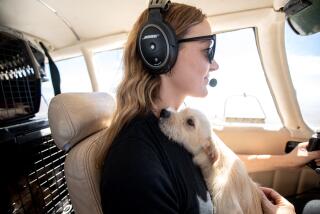Doggy Blood Donors Roll Up Their Paws
- Share via
QUAKERTOWN, Pa. — Sport, an energetic English springer spaniel, bounced onto the canine bloodmobile, his ears flopping.
Like Pavlov’s dogs, experience had taught him to expect a treat and he was already looking for it.
“I swear he knows,” said Elaine Gorman, who brought Sport to the blood drive at a school in Bucks County, about 40 miles from Philadelphia. “He sees the bus and he knows he’s going to get a treat.”
The dog-only bloodmobile owned by the University of Pennsylvania is believed to be the only one of its kind in the country, officials at Penn’s School of Veterinary Medicine say. The white bus travels to blood drives organized by breeders, dog clubs, veterinarians and others in Pennsylvania, New Jersey, Delaware and Maryland to collect blood for its well-known veterinary hospital.
“We can’t ask the dog for the donation, but we most certainly will not force any dog to donate blood,” said Urs Giger, head of the veterinary school’s transfusion medical program. “In other words, these dogs are good-tempered dogs that are not stressed by the procedure.”
Sport, who recently made his ninth visit to the Penn Animal Bloodmobile, didn’t seem stressed as he lay on a metal table so that a veterinary technician could shave a patch of his silky fur and draw a pint of blood from a vein.
The number of pets donating blood has increased, but transfusions also are on the rise, partly because more people are opting to have their dogs undergo life-saving surgery, said Wendy Hatchett, a veterinary technician.
“For the last 1 1/2 years, we haven’t had enough because more people are using” the doggy blood bank, said Hatchett, who spoke sweetly to Sport as she slid a needle into his neck. “Now, [blood transfusions] are becoming more and more common all around the country.”
Dogs are tested the first time they donate and those with blood that cannot be universally transfused are turned away. The bloodmobile doesn’t allow cats because they need to be anesthetized to draw blood.
The blood -- taken from a jugular because it is a large vein and can withstand the pressure of a suction pump -- will be deposited into the Penn Animal Blood Bank, which has about 1,000 active donors and is the largest voluntary canine blood donor program in the country.
The blood is used primarily at the University of Pennsylvania, which does about 10 transfusions each day. In some cases, the blood is separated into products that treat diseases and disorders.
Tuscany, a powerful Doberman pinscher who strutted onto the bloodmobile for his 20th donation, has a reputation for squirming on the table.
“This is for dogs that are sick,” Vera Belsky said as she held Tuscany’s head still. “If one of my dogs was sick and needed surgery at Penn, there’s blood there.”
One of the bonuses for owners who bring a dog to the bloodmobile is the promise of free blood from the blood bank. The blood usually costs about $100 a pint, Hatchett said.
Susan Watts talked directly to her boxer about the other animals that she might be saving.
“Just relax. Just key down,” she told Penny, a black-and-tan 3-year-old who panted heavily as blood flowed from her neck. “You’re going to help so many other dogs.”
Christine Shister talked to Gus, her German shepherd, a little more bluntly about his duty.
“Other dogs need this. And if you ever need surgery, we’ll need it,” she told him as he lay on his right side, fidgeting. Three people held him down as Hatchett drew his blood.
Jaime Greiser, a student at Upper Bucks County Vo-Tech School, held Gus down as the pump’s generator hummed in the background.
“I think they are more scared about being held down than by having their blood taken,” he said.
After about five minutes, the needle was out and Gus was getting his treat: a bowl of food.
“That’s the orange juice and doughnuts,” Hatchett said.
More to Read
Sign up for Essential California
The most important California stories and recommendations in your inbox every morning.
You may occasionally receive promotional content from the Los Angeles Times.













